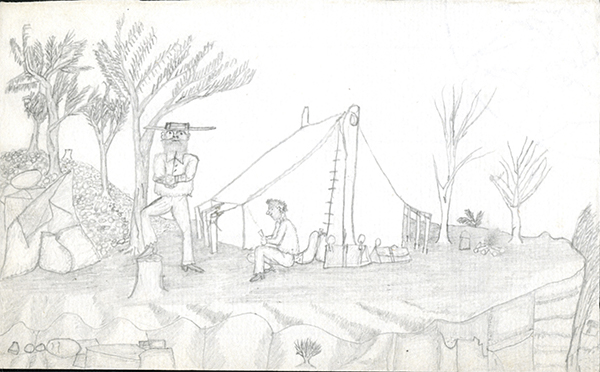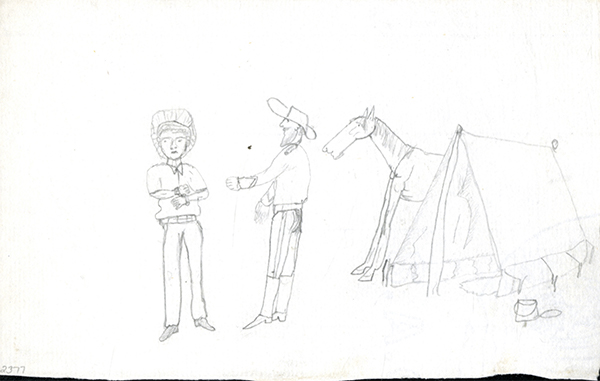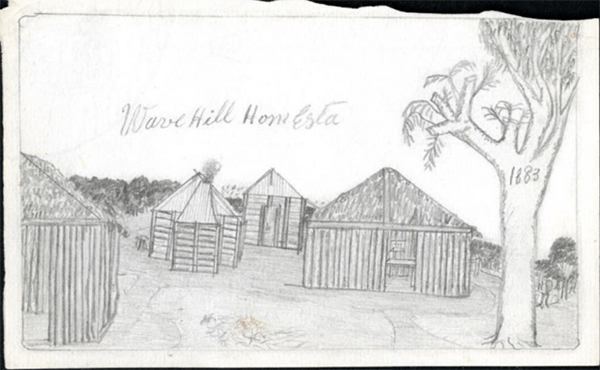Rhiannon Clarke, 130-year-old prison drawings of First Nations stockman captures rare perspective of 19th-century frontier, National Indigenous Times, May 2, 2023
The drawings of the executed Aboriginal stockman Charlie Flannigan offer an extraordinary visual record of life on the 19th-century frontier.
Sketched in the shadow of the gallows, the first man to be executed in the Northern Territory’s works will be shared with the public for the first time in a new exhibition at the South Australian Museum.
The origin of this remarkable body of work tells a complex history, going back to 1892 when the Northern Territory was gripped by a controversial murder trial.
The former prize-winning jockey stood accused of shooting dead Samuel Croker, the white manager of Auvergne Station near the Northern Territory and Western Australian border.
At trial, authorities struggled to gain a clear picture of why the night of 20 September 1892 ended in bloodshed.
The two men had been seen playing cards shortly before the gunshots, but some accounts suggest there were deeper tensions at play.
Croker had previously been involved in the frontier killings of other First Nations people, and one eyewitness claimed Flannigan feared Croker planned to shoot him first.

“Croker has carried a revolver for a fortnight for the purpose of killing me,” Flannigan was heard saying.
Flannigan pled not guilty to the murder but declined to defend himself in court. His sentence made him the first man to be hanged in the Northern Territory.
His sentence inspired intense public debate as a white man found guilty of murder around the same time was sentenced to hard labour.
As one newspaper reported, “the public conscience has never before been so deeply stirred by a keen sense of injustice”.
While other commentators argued it was a “scandalous shame” that “even-handed justice was not being done.”
But it was in solitary confinement at Fannie Bay Gaol that Flannigan committed a surprising legacy to paper.
Given rudimentary art supplies by warders who were worried he might escape or take his life, Flannigan completed an astonishing 82 drawings that vividly document his life as a drover and Aboriginal man in 19th-century Australia.

For a century these sketches were preserved in the South Australian Museum Archives, until a chance discovery by Darwin-based historian and Library & Archives NT.
Curator Don Nawurlany Christophersen was inspired to bring Flannigan’s story and artistry to light once again.
“I wanted to do the story justice, to tell his story the right way,” Christophersen said.
“He’s trying to tell us, ‘this is what happened, this is what I saw’. It’s his life that he’s chronicling, where he’s worked, what he did, right up to the last image of Fannie Bay Gaol.”
Little is known about Flannigan’s art practice, or whether he even picked up a pencil before his conviction, with a playful style that recalls the newspaper cartoonists of the era.
This body of work offers a personal and energetic first-person account of Flannigan’s short and eventful life, from detailed studies of colonial architecture to horseback scenes that evoke the thrill and freedom of working on Country.
“He got better and better in the ten months he was in gaol,” Mr Christophersen said.
“You can imagine him sitting, shackled in his small cell, with nothing to look at other than what’s in his head – and he recreates those images in paper.”

Curated by Mr Christophersen, A Little Bit of Justice shines an overdue spotlight on Flannigan’s artwork and story.
Following an initial run at Library & Archives NT, its South Australian Museum season will include several of Flannigan’s original sketches on display for the first time.
“Today, we look at them in a totally different light. It’s him talking to us from the grave, really – who would have thought 130 years later, we’re telling his story again?” said Mr Christophersen.
South Australian Museum Acting Director Justine van Mourik said A Little Bit of Justice is a testament to the rich, untold stories kept alive in the Museum’s archives.
“For over a century the South Australian Museum has been the custodian of Charlie Flannigan’s unique perspectives on 19th century Australia,”
“It’s a privilege to finally recognise Charlie, his skill as an artist, and the complexities of his life story, with the public,” she said.
The Library & Archives NT Exhibition A Little Bit of Justice: the Drawings of Charlie Flannigan opens on Saturday 5 May 2023 and runs until Sunday 10 September 2023. Entry is free.

